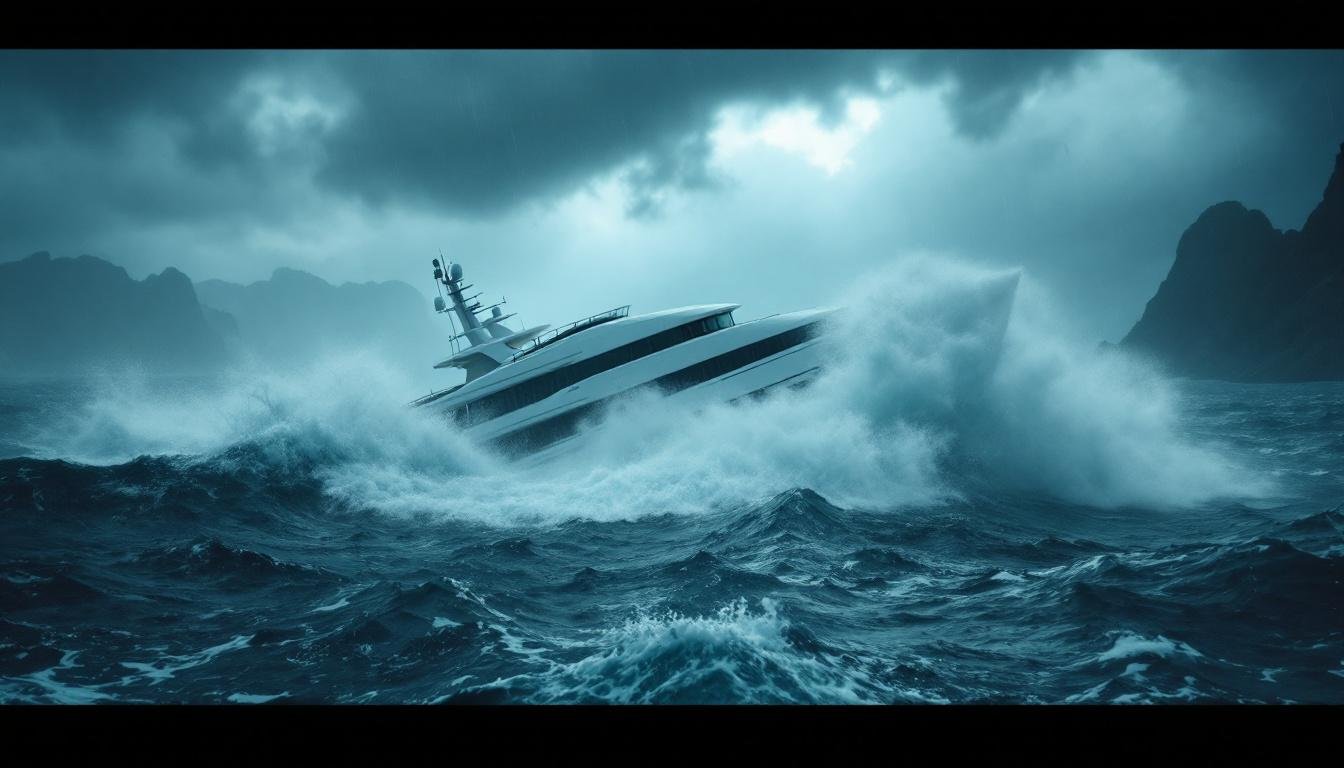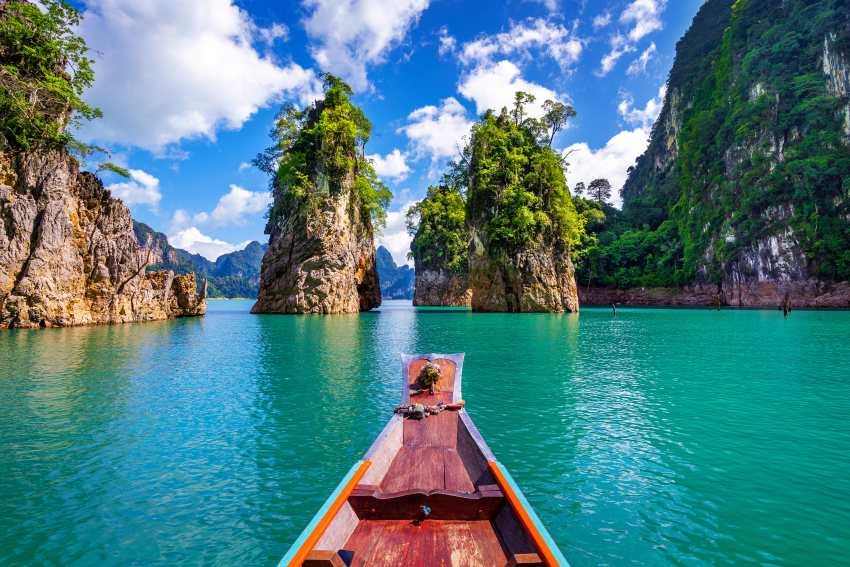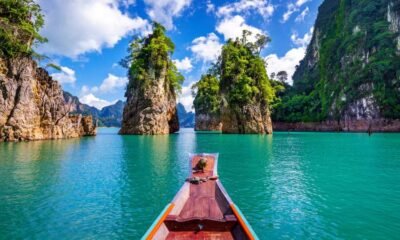Asia Travel Pulse
Halong Bay Tragedy: A Sudden Storm Claims The Lives Of Thirty Seven Tourists And Crew Members – What Went Wrong in Vietnam’s Popular Tourist Destination?

Sunday, July 20, 2025
In a tragic incident, a tourist boat with 48 passengers and 5 crew members capsized on July 19, 2025, near Ti Top Island in Halong Bay of Vietnam reckoned as a majestic and popular natural world wonder in Southeast Asia. Without warning, the unexpected disaster caused 37 deaths and 10 survivors. It is a tragedy that has stunned the local community – and the global tourism industry – and prompted serious questions over safety regulations around maritime tours in the blue waters of Halong Bay. Well-known for its calm waters, towering limestone islands and picturesque scenery, Halong Bay has for decades been a top destination for international tourists. pyt Many visit relatives of Vietnamese descent, And their death is a grim incident haunting the idyll of the pensive lagoon, The mountain, the river, and the cataract, The cattle, the cliff, and the rustling trees. The tragedy is shedding light on the difficulties of tourism’s push-pull between providing popular travel experiences and safeguarding those who take the road less traveled safely.
The boat flipped over around 13:45 local time (21:45 GMT) on Thursday on what was meant to be a regular sightseeing trip. Most of the passengers on the boat, had been families from Hanoi, and more than 20 of them were children. Try as they might, however, the good ship was overtaken by a thunderstorm and what had been calm seas became a tumultuous ocean. The strength of the storm capsized the vessel in the world-famous Ha Long Bay World Heritage Site. By early July 20, the tally of the dead had reached 37 and the search for bodies continued.
This tragedy is having a deep impact. It has been a shadow on the image of Halong Bay as one of the most attractive destinations of Vietnam, prompting local authorities to reconsider the safety of the maritime tourism industry there. The incident also raises questions about regulation, weather safety and the response of authorities in one of the most traveled areas of the country.
Halong Bay: A Global Natural Treasure
Halong Bay, located in Quang Ninh Province, northeastern Vietnam, is often referred to as one of the natural wonders of the world. With over 1,600 limestone islands and islets, many of which are uninhabited, the bay is a UNESCO World Heritage Site, celebrated for its majestic beauty and serene landscapes. The site’s popularity has been bolstered by its unique geographical features, which are the result of millions of years of geological processes. These towering rock formations, with their caves, grottoes, and lush forests, provide a dramatic backdrop for cruise tours, kayaking, and sightseeing. Halong Bay has also become a favorite location for filming movies and documentaries.
While the beauty of Halong Bay has made it a symbol of Vietnam’s natural grandeur, it has also attracted an overwhelming number of tourists. In recent years, the tourism industry has seen exponential growth, with boat tours being one of the most popular activities for travelers. However, the increase in the number of visitors has led to growing concerns over the environmental impact of tourism, as well as the adequacy of safety regulations and infrastructure to accommodate large numbers of people.
The Tragic Incident: A Day of Horror for Tourists
The ill-fated voyage aboard the Vinh Xanh 58 tourist boat was meant to be a picturesque afternoon tour of the bay’s stunning landscape. The boat, carrying mostly families, departed from the mainland to explore the serene waters. Among the passengers were over 20 children, the youngest of whom was only three years old. The oldest passenger was 53, a reminder of the diverse group of tourists who come to Halong Bay seeking relaxation and adventure.
At approximately 1:45 PM local time, a sudden and severe thunderstorm caught the boat off guard. While storms in Halong Bay are not uncommon, the rapid onset of this one left little time for preparation or evacuation. With little warning, powerful winds and heavy rain overwhelmed the boat. The boat, which was likely not designed to withstand such sudden weather conditions, capsized in the choppy waters of the bay. Many passengers were thrown into the water, while others remained trapped inside the overturned vessel.
The swift response of local authorities, including the Vietnam Coast Guard, meant that rescue operations began almost immediately. However, the challenge of navigating Halong Bay’s waters and strong currents made the operation extremely difficult. As the search continued throughout the night, divers recovered the bodies of 37 individuals. Four of the victims’ identities remain unverified, highlighting the scale of the disaster and the difficulty in identifying the deceased in such conditions.
The Response: Swift Actions in the Wake of Disaster
Following the tragic incident, the Vietnamese government moved quickly to coordinate search and rescue operations. Prime Minister Pham Minh Chinh issued an urgent dispatch on July 19, directing the Ministry of National Defense and the Ministry of Public Security to mobilize all available resources. Local authorities in Quang Ninh Province, aided by search teams and rescue divers, worked tirelessly to recover the bodies and assist the survivors. As of July 20, 10 people had been rescued from the waters.
The boat, which was salvaged and towed back to shore, was examined for further investigation. While the cause of the incident is yet to be definitively determined, there has been much speculation that the storm’s sudden onset played a significant role. The weather conditions that day, while unusual, are not entirely unpredictable for the region, raising questions about the preparedness of both boat operators and tourists. Vietnam’s National Center for Hydro-Meteorological Forecasting has indicated that the heavy rainfall was not due to Typhoon Wipha, which was affecting other parts of the region, but rather to localized wind patterns.
Safety Concerns and Regulations for Maritime Tourism in Vietnam
This tragic event brings into focus the growing concerns over safety measures for tourist boats in Halong Bay. While the region has taken steps in recent years to improve safety protocols, such as requiring life jackets and emergency equipment for passengers, the unforeseen nature of the storm reveals significant gaps in readiness for sudden weather shifts. Although boats operating in the bay are generally required to follow certain safety standards, these measures often fall short in the face of unpredictable natural conditions.
The Vietnamese government and local authorities have long acknowledged the importance of maintaining rigorous safety standards in Halong Bay’s tourism industry. Operators are required to ensure their vessels are up to code, with qualified crews and appropriate safety gear. In addition, the introduction of weather monitoring systems has helped alert boat operators to incoming storms. However, the recent capsizing suggests that these measures may not be enough to prevent accidents, particularly in the face of sudden, intense weather changes.
It is clear that more attention needs to be given to ensuring boats are equipped to handle these challenges, and that operators are well-trained in how to respond to emergencies in real time. Additionally, passengers may need better awareness about the potential risks involved in maritime tourism, particularly in regions with unpredictable weather patterns.
Halong Bay’s Tourism Industry: Impact and Future
The impact of this tragedy will undoubtedly reverberate through Halong Bay’s tourism sector. Vietnam’s tourism industry has seen a steady increase in visitor numbers over the past decade, with Halong Bay being one of the country’s biggest draws. However, the capsizing of the Vinh Xanh 58 boat will likely lead to a temporary decline in visitor confidence, especially in light of concerns over safety.
Experts predict that the immediate aftermath of this tragedy will include an increased focus on safety reforms. Local authorities may implement more stringent regulations for maritime tourism in Halong Bay, including better weather forecasting and faster response times for emergencies. There is also likely to be an emphasis on training for boat operators, ensuring they are well-versed in handling difficult conditions and emergencies.
While such incidents can shake the confidence of tourists, the allure of Halong Bay’s natural beauty is unlikely to diminish in the long term. The region’s unique landscapes and cultural significance remain a key draw for travelers from around the world. In the wake of this tragedy, it is anticipated that Halong Bay’s tourism industry will emerge stronger, with improved safety measures in place to protect future visitors.
Conclusion: A Devastating Reminder of Nature’s Power and Safety Imperatives
The capsizing of the Vinh Xanh 58 boat in Halong Bay is a tragedy that will be remembered for years to come. It serves as a powerful reminder of the unpredictable nature of weather, particularly in maritime environments. While Halong Bay’s natural beauty continues to captivate travelers, this event underscores the need for heightened safety measures, more effective emergency response systems, and better weather preparedness for tourist boats.
As the recovery operation concludes and investigations continue, it is hoped that lessons will be learned from this disaster. The authorities must ensure that such a tragedy never occurs again, and that Halong Bay remains a safe and welcoming destination for tourists in the years ahead.
Asia Travel Pulse
Breaking: Barcelona captain will not travel to asia; could be out for four months as surgery looms

Barcelona captain Marc-Andre ter Stegen could be set for an extended spell on the sidelines as the goalkeeper is strongly considering opting for surgery to overcome persistent back problems.
The German goalkeeper had been struggling with persistent lower back pain throughout the summer and missed much of pre-season training.
While there had been internal discussions on whether rest and rehabilitation could solve the issue, ter Stegen is now reportedly serious about going under the knife in an attempt to fully recover before the crucial stages of the campaign.
Ruled out for four months
According to Mundo Deportivo, ter Stegen’s surgery could rule him out for a period of four months at least.
The report adds that the German will not be part of the flight to Kobe on Thursday morning, when the team departs for the Asia leg of their preseason preparations.
While the injury is a blow from a sporting perspective, it does offer some relief on the financial front.
Under La Liga’s injury clause, 80% of ter Stegen’s salary can now be removed from the wage bill, allowing Barcelona more space to register a new signing.
This, in turn, could help Barcelona to register Joan Garcia, at the very least, thus paving the way for the club to elevate the Spaniard into a first-choice role next season.
Barcelona will also try to register Marcus Rashford, who is expected to arrive in Barcelona shortly. The Englishman is set to join the club on a season-long loan deal, with the club having the option to sign him permanently next summer.
But for now, Barcelona are expected to utilise ter Stegen’s salary to register Joan Garcia.
Asia Travel Pulse
Tourist Safety at Risk: Boat Capsize Incidents in Thailand and Vietnam Highlight Urgent Need for Enhanced Security Measures

Sunday, July 20, 2025
On 20 July 2025, an accident happened at the Ratchaprapha Dam in Surat Thani, Thailand, where at least one person died, and indicated the necessity to take action to improve tourists’ safety with boat tours. A tourist boat carrying foreigners sank; one Thai tour guide was killed, but the tourists sustained no injuries. It’s a tragedy that didn’t have to happen, and it’s been a problem throughout the year, from a fatal boat capsize in Vietnam to fears about how safe tourists are while taking to the water for country excursions.
A Fatal Incident at Ratchaprapha Dam
The disaster unfolded around 11:28 AM, when the boat, which was carrying 18 individuals, including 16 foreign tourists and two Thai nationals—a tour guide and the boat operator—overturned. The group was navigating the serene waters of the Ratchaprapha Dam, located in the picturesque Khao Sok National Park, an area renowned for its stunning limestone mountains, lush rainforests, and tranquil reservoirs.
Among the 16 tourists, five were from Belgium and 11 were from the Netherlands, all of whom were unhurt in the mishap. Tragically, the tour guide, a 44-year-old woman named Thassawan, was discovered unconscious after inhaling water, and despite being rushed to Ban Ta Khun Hospital for medical treatment, she was later pronounced dead. This marked the first fatality associated with a boat tour at Ratchaprapha Dam in recent years. The authorities immediately launched an investigation into the cause of the capsizing, and a full inquiry into safety practices in the region was initiated. The tour guide, Thassawan, was a licensed professional with a valid permit that was set to expire in November 2029.
Despite the tragic loss of life, the remaining passengers were swiftly rescued and were unharmed. The incident has drawn significant attention, as it occurred in a popular destination, attracting thousands of international tourists annually.
The Broader Picture: A Look at Similar Incidents in Southeast Asia
The Thailand capsizing incident is unfortunately not an isolated case. Recently, a similar tragedy occurred in Vietnam, where a boat capsized in a popular tourist area, leaving casualties in its wake. Though no fatalities were reported, the incident sparked debates about the preparedness of local authorities and tour operators when it comes to the safety of visitors engaging in water-based activities. These recurring accidents have raised alarms about the need for greater oversight, more rigorous safety measures, and enhanced regulations in Southeast Asia’s popular tourist destinations, especially those offering boat tours and other water-based activities.
While both Thailand and Vietnam boast picturesque landscapes and are known for their vast natural beauty, these incidents shine a light on the vulnerabilities tourists face when engaging in certain recreational activities. Whether navigating the iconic limestone cliffs of Phang Nga Bay in Thailand or the lush riverways of Vietnam, safety must be a top priority to ensure that tourists can enjoy the breathtaking beauty of these regions without compromising their well-being.
Tourist Safety Measures: An Urgent Need for Reform
In the aftermath of these incidents, it is evident that both Thailand and Vietnam need to strengthen their tourist safety protocols, particularly for boat tours. While both countries have made significant strides in promoting their tourism industries, safety regulations often fail to keep pace with the rapid rise in visitor numbers and the increasing demand for water-based experiences. It is crucial that the governments of both nations, along with local tourism authorities, implement more comprehensive safety measures to safeguard the well-being of tourists.
Tour operators in both countries must be held accountable for ensuring their vessels are properly maintained and meet international safety standards. This includes routine inspections, appropriate safety gear, and well-trained crew members who are equipped to handle emergency situations. Additionally, tour operators should ensure that their guests are briefed on proper safety procedures and emergency protocols before embarking on any trip.
The Thai government, through the Ministry of Tourism and Sports, has already recognized the importance of enhancing safety measures, particularly in popular destinations like Ratchaprapha Dam. In the wake of the capsizing incident, local authorities in Surat Thani have vowed to review and improve their safety guidelines for boat tours, ensuring that incidents like this do not repeat themselves.
The Role of Tourism Authorities in Ensuring Safety
In the aftermath of the capsizing at Ratchaprapha Dam, the local tourism authorities in Surat Thani have promised to closely investigate the incident and make necessary changes to prevent future accidents. The authorities have stressed that there will be heightened scrutiny on boat tour operators and safety protocols in the region. Further investigations into the technical aspects of the boat, as well as the conduct of the operator and tour guide, are underway.
Both Thailand’s Ministry of Tourism and Sports and Vietnam’s Ministry of Culture, Sports, and Tourism should also consider forming cross-border collaborations to enhance safety regulations across Southeast Asia. By sharing best practices and jointly tackling safety concerns, these nations can improve the overall experience for tourists while minimizing the risks associated with water-based tours.
Preventative Measures: A Global Approach
Tourist safety on water should not only be a regional concern for Southeast Asia but also a global priority. Countries worldwide, especially those with popular natural sites and water attractions, should adopt uniform safety standards that include proper vessel inspections, mandatory safety gear (such as life vests), emergency drills, and well-trained staff to handle emergencies.
International tourism organizations, such as the United Nations World Tourism Organization (UNWTO), can play a pivotal role in supporting countries like Thailand and Vietnam by offering expertise, resources, and guidelines for enhancing safety. Moreover, tourists themselves need to be more informed about the risks associated with water-based activities and take personal responsibility for their own safety, ensuring they follow safety protocols at all times.
Conclusion: Moving Forward with Enhanced Tourist Safety
While the Ratchaprapha Dam and Vietnam incidents illustrate major issues with tourist safety, they also underscore the fact that this may finally be a wake-up call for governments and tourism authorities to better regulate tourist safety. The tragedy highlights the point that while travelling the world’s natural wonders is always a memorable adventure, safety should remain a top concern.
To make every unfortunate case such as this provide recommendations for best practice and work together with Thailand, Vietnam, and similar popular water-based destinations where the natural beauty of these landscapes is shared globally in a safe and responsible manner.
References: Tourism Authority of Thailand (TAT)—Official Website, Vietnam Ministry of Culture, Sports, and Tourism
Asia Travel Pulse
How Da Nang’s Coastal Routes Are Becoming A Must-Visit For Luxury Travelers

Sunday, July 20, 2025
Da Nang, a famous city located right at the beach of Vietnam, is always the pit stop of most tourists looking for a stopover of modernization and nature. However, its coastal and island areas are still largely undiscovered, offering huge tourism potential. The recent years have seen more concentration on developing the sea and island tourism products of Da Nang as high-quality products. One of the few remaining marine ecosystems in big-city Vietnam to remain completely untouched, the biodiverse region’s pristine beaches and stunning landscapes have flown under the radar until now—and Hue City’s recent buy of Son Cha Island has only increased its appeal.
The Untouched Charm of Da Nang’s Sea and Islands
Da Nang’s coastline, especially areas such as Da Nang Bay, Son Tra Peninsula, and Hai Van Mountain, offers some of the most unspoiled natural beauty in Vietnam. According to long-standing travel and tour operators, these areas are considered hidden treasures, still largely unexplored by mass tourism. The Son Tra Peninsula, which is surrounded by ten pristine beaches, including Tien Sa, Da Den, Cat Vang, and Mieu beaches, provides an ideal setting for ecotourism. Many of these beaches remain largely untouched, offering visitors a rare opportunity to experience nature in its purest form.
Additionally, Da Nang Bay, with its sheltered position between the Hai Van and Son Tra mountains, is an excellent location for marine activities, particularly during the peak tourist season from March to September. The region’s calm waters and protected landscapes are perfect for travelers seeking outdoor adventures like swimming, kayaking, and diving. The spectacular views, with forests on one side and the shimmering ocean on the other, create an enchanting environment for exploration.
Son Cha Island: A Newly Acquired Jewel
In 2025, Da Nang officially received Son Cha Island, located at the foot of Hai Van Mountain, from Hue City. Previously part of the Phu Loc District in Thua Thien Hue Province, the island, also known as Hon Chao or Pearl Island, lies 235 meters above sea level and covers approximately 1.5 square kilometers. This unspoiled island, with its lush greenery and crystal-clear waters, has the potential to transform into a world-class ecotourism destination.
The island’s marine ecosystem is rich, with over 144 coral species, 135 seaweed species, and 162 colorful fish species, creating an underwater paradise that attracts divers and marine enthusiasts. The fine white sand and pristine beaches make it an ideal getaway for those looking to escape the hustle and bustle of the city and immerse themselves in nature.
Opportunities for High-End Marine Tourism Development
While some tourism operators have begun to offer diving tours and sightseeing trips along Da Nang’s coastline, the number of such services remains limited. There is significant potential for developing high-end marine tourism, particularly in areas like Son Cha Island, which has been proposed as an exclusive eco-resort catering to ultra-luxury travelers. The island’s natural beauty and seclusion make it an attractive destination for high-net-worth individuals seeking privacy, luxury, and an authentic natural experience.
In addition to Son Cha Island, several other parts of Da Nang’s coast are being developed into premium resorts and ecotourism destinations. With the growing trend of luxury travel, Da Nang’s untouched islands and beaches have been identified as prime locations for investment in eco-friendly resorts and high-end tourism products.
Expanding Inland Waterway Tourism
Da Nang is also making strides to expand its tourism offerings by investing in inland waterway tourism. The CT15–Hon Sup–Bai Nam–Bai Da inland waterway route, which attracts increasing attention from water transport companies, is an essential part of this vision. Plans to expand this route include the development of new water transport options that can bring tourists closer to natural wonders like the Son Tra Peninsula and Son Cha Island. This expansion will help boost Da Nang’s tourism appeal, particularly for those who enjoy traveling by boat and exploring remote locations by water.
The Da Nang Department of Culture, Sports, and Tourism has already developed a tourism plan for inland waterways through 2030, with a long-term vision extending to 2045. This includes the construction of modern ports and terminals and the introduction of high-speed boats, cruise ships, and overnight vessels. The city is committed to enhancing its marine tourism infrastructure to cater to the growing number of tourists who seek unique and diverse experiences.
Leveraging the Han River and Coastal Areas
Alongside its sea routes, the Da Nang People’s Committee has unveiled plans to organize water-based entertainment activities along the Han River and the city’s coastal areas. This initiative, set to run from 2025 to 2030, aims to offer a wide range of leisure activities, from boat tours to water sports, all designed to attract both domestic and international tourists. The move is part of a broader strategy to diversify Da Nang’s tourism products and cater to a wide range of traveler preferences.
The development of these water-based activities is expected to not only enhance the tourist experience but also contribute to the local economy. By tapping into the potential of the Han River and the surrounding coastal landscapes, Da Nang aims to position itself as a prominent destination for marine tourism in Vietnam.
Conclusion: A Bright Future for Da Nang’s Sea and Island Tourism
With a beautiful coastline, clean islands, and a focus on sustainable tourism, Da Nang is on course to be one of the top destinations in Southeast Asia for ecotourism and marine activities. With the addition of Son Cha Island and the new inland waterway routes, there will be a very exciting period of growth to come for Da Nang’s tourism industry. The city is also adding investment to nurture its natural resources in combination with its infrastructure, attracting many tourists from global destinations to experience the beauty and peacefulness of the sea and island travel routes of Da Nang.
References: Da Nang Department of Culture, Sports, and Tourism (Official Government Website)
-

 Mergers & Acquisitions1 week ago
Mergers & Acquisitions1 week agoAmazon weighs further investment in Anthropic to deepen AI alliance
-

 Mergers & Acquisitions1 week ago
Mergers & Acquisitions1 week agoHow Elon Musk’s rogue Grok chatbot became a cautionary AI tale
-

 Asia Travel Pulse2 weeks ago
Asia Travel Pulse2 weeks agoLooking For Adventure In Asia? Here Are 7 Epic Destinations You Need To Experience At Least Once – Zee News
-

 Brand Stories2 weeks ago
Brand Stories2 weeks agoVoice AI Startup ElevenLabs Plans to Add Hubs Around the World
-

 Mergers & Acquisitions1 week ago
Mergers & Acquisitions1 week agoUK crime agency arrests 4 people over cyber attacks on retailers
-

 AI in Travel2 weeks ago
AI in Travel2 weeks ago‘Will AI take my job?’ A trip to a Beijing fortune-telling bar to see what lies ahead | China
-

 Mergers & Acquisitions1 week ago
Mergers & Acquisitions1 week agoEU pushes ahead with AI code of practice
-

 Mergers & Acquisitions2 weeks ago
Mergers & Acquisitions2 weeks agoChatGPT — the last of the great romantics
-

 The Travel Revolution of Our Era1 month ago
The Travel Revolution of Our Era1 month agoCheQin.ai Redefines Hotel Booking with Zero-Commission Model
-

 Mergers & Acquisitions1 week ago
Mergers & Acquisitions1 week agoHumans must remain at the heart of the AI story













You must be logged in to post a comment Login